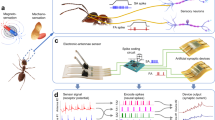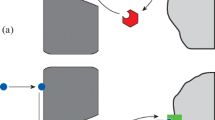Abstract
Honeybees learn and discriminate excellently between different surface structures and different forms of objects, which they scan with their antennae. The sensory plate on the antennal tip plays a key role in the perception of mechanosensory and gustatory information. It is densely covered with small tactile hairs and carries a few large taste hairs. Both types of sensilla contain a mechanoreceptor, which is involved in the antennal scanning of an object. Our experiments test the roles of the mechanoreceptors on the antennal tip in tactile antennal learning and discrimination. Joints between head capsule and scapus and between scapus and pedicellus enable the bee to perform three-dimensional movements when they scan an object. The role of these joints in tactile antennal learning and discrimination is studied in separate experiments. The mechanoreceptors on the antennal tip were decisive for surface discrimination, but not for tactile acquisition or discrimination of shapes. When the scapus–pedicellus joint or the headcapsule–scapus joint was fixed on both antennae, tactile learning was still apparent but surface discrimination was abolished. Fixing both scapi to the head capsule reduced tactile acquisition.





Similar content being viewed by others
Abbreviations
- CS:
-
Conditioned stimulus
- PER:
-
Proboscis extension response
References
Dacher M, Lagarrigue A, Gauthier M (2005) Antennal tactile learning in the honeybee: effect of nicotinic antagonists on memory dynamics. Neurosci 130:37–50
Eichmüller S, Schäfer S (1995) Sensory neuron development revealed by taurine immunocytochemistry in the honeybee. J Comp Neurol 352:297–307
Erber J, Pribbenow B (2000) Antennal movements in the honeybee: how complex tasks are solved by a simple neuronal system. In: Cruse H, Dean J, Ritter H (eds) Prerational intelligence: adaptive behavior and intelligent systems without symbols and logic—Vol. 1. Kluwer Academic Publishers, Dordrecht, Boston, London, pp 109–122
Erber J, Pribbenow B, Grandy K, Kierzek S (1997) Tactile motor learning in the antennal system of the honeybee (Apis mellifera). J Comp Physiol A 181:355–365
Erber J, Kierzek S, Sander E, Grandy K (1998) Tactile learning in the honeybee. J Comp Physiol A 183:737–744
Erber J, Pribbenow B, Kisch J, Faensen D (2000) Operant conditioning of antennal muscle activity in the honeybee (Apis mellifera L.). J Comp Physiol A 186(6):557–565
Esslen J, Kaissling KE (1976) Number and distribution of the sensilla on the antennal flagellum of the honeybee (Apis mellifera). Zoomorph 83:227–251
Giurfa M, Malun D (2004) Associative mechanosensory conditioning of the proboscis extension reflex in honeybees. Learn Mem 11:294–302
Goodwin AW (1993) The code for roughness. Curr Biol 3(6):378–379
Haupt SS (2004) Antennal sucrose perception in the honeybee (Apis mellifera L.): behaviour and electrophysiology. J Comp Physiol A 190(9):735–745
Jay SC (1963) The longitudinal orientation of larval honeybees (Apis mellifera L.) in their cells. Can J Zool 41:717–723
Kevan PG, Lane MA (1985) Flower petal microtexture is a tactile cue for bees. Proc Natl Acad Sci USA 82:4750–4752
Kloppenburg P (1995) Anatomy of the antennal motoneurons on the brain of the honeybee (Apis mellifera). J Comp Neurol 363:333–343
Martin H (1965) Leistungen des topochemischen Sinnes bei der Honigbiene. J Comp Physiol 50:254–292
Martin H, Lindauer M (1966) Sinnesphysiologische Leistungen beim Wabenbau der Honigbiene. Zeitschr vgl Physiol 53:372–404
Scheiner R, Erber J, Page RE (1999) Tactile learning and the individual evaluation of the reward in honeybees (Apis mellifera L.). J Comp Physiol A 18(1):1–10
Scheiner R, Page RE, Erber J (2001a) Responsiveness to sucrose affects tactile and olfactory learning in preforaging honeybees of two genetic strains. Behav Brain Res 120(1):67–73
Scheiner R, Page RE, Erber J (2001b) The effects of genotype, foraging role, and sucrose responsiveness on the tactile learning performance of honeybees (Apis mellifera L.). Neurobiol Learn Mem 76(2):138–150
Scheiner R, Weiß A, Malun D, Erber J (2001c) Learning in honeybees with brain lesions: how partial mushroom-body ablations affect sucrose responsiveness and tactile learning. Anim Cogn 4:227–235
Scheiner R, Barnert M, Erber J (2003) Variation in water and sucrose responsiveness during the foraging season affects proboscis extension learning in honeybees. Apidologie 34:67–72
Scheiner R, Page RE, Erber J (2004) Sucrose responsiveness and behavioral plasticity in honeybees (Apis mellifera). Apidologie 35:133–142
Tezze AA, Farina WM (1999) Trophallaxis in the honeybee, Apis mellifera: the interaction between viscosity and sucrose concentration of the transferred solution. Anim Behav 57(6):1319–1326
Wainselboim AJ, Farina WM (2000) Trophallaxis in filled-crop honeybees (Apis mellifera L.): food-loading time affects unloading behaviour. Naturwissenschaften 87(6):280–282
Wainselboim AJ, Farina WM (2003) Trophallaxis in honeybees, Apis mellifera (L.), as related to their past experience at the food source. Anim Behav 66 (4):791–795
Whitehead AT, Larsen JR (1976) Ultrastructure of the contact chemoreceptors of Apis mellifera L. (Hymenoptera: Apidae). Int J Insect Morphol Embryol 5:301–315
Acknowledgements
We would like to thank Stephan S. Haupt and Joachim Haupt for helpful comments on earlier versions of this manuscript. This work was supported by a grant of the DFG (SFB 515) to J. Erber. The experiments described in this paper comply with the “Principles of animal care”, publication No. 86–23, revised 1985 of the National Institute of Health, and with the current German laws.
Author information
Authors and Affiliations
Corresponding author
Rights and permissions
About this article
Cite this article
Scheiner, R., Schnitt, S. & Erber, J. The functions of antennal mechanoreceptors and antennal joints in tactile discrimination of the honeybee (Apis mellifera L.). J Comp Physiol A 191, 857–864 (2005). https://doi.org/10.1007/s00359-005-0009-1
Received:
Revised:
Accepted:
Published:
Issue Date:
DOI: https://doi.org/10.1007/s00359-005-0009-1




